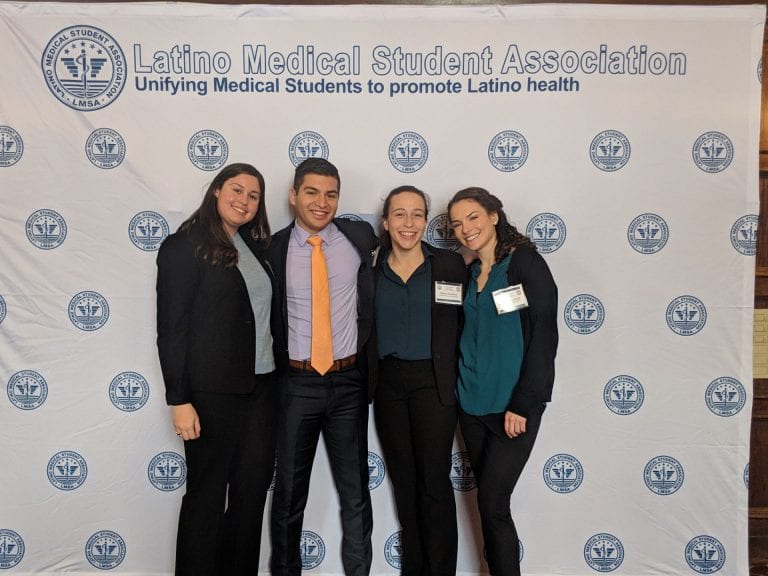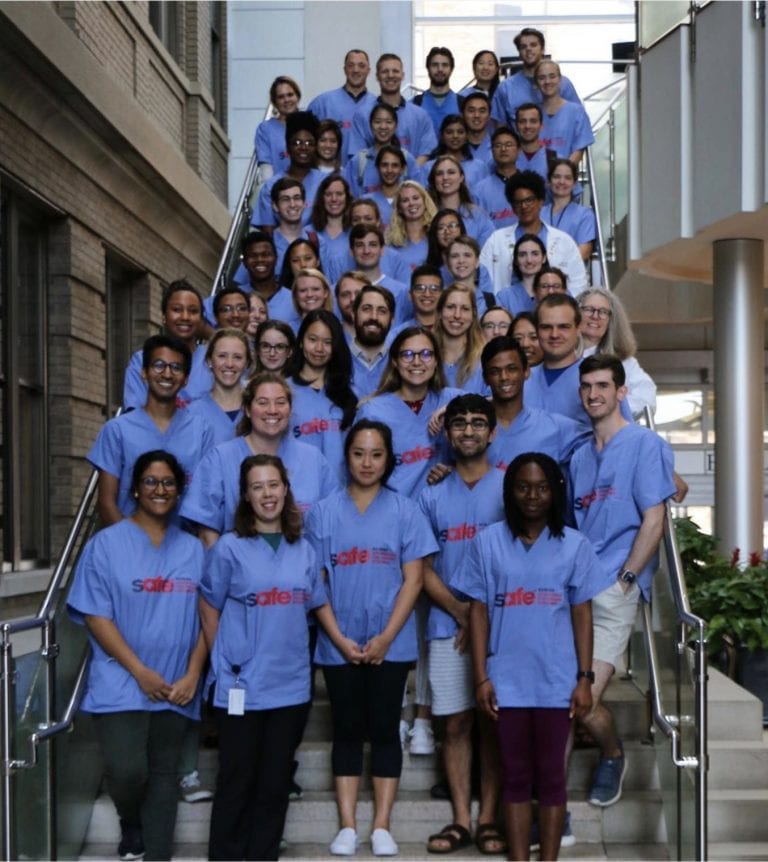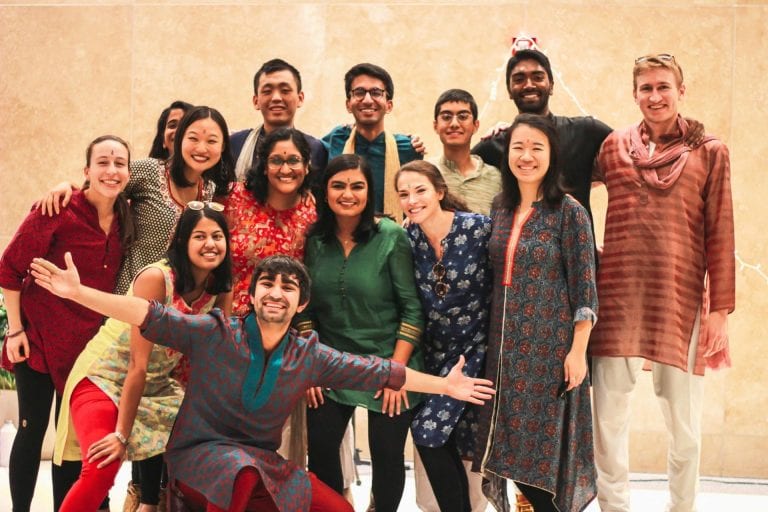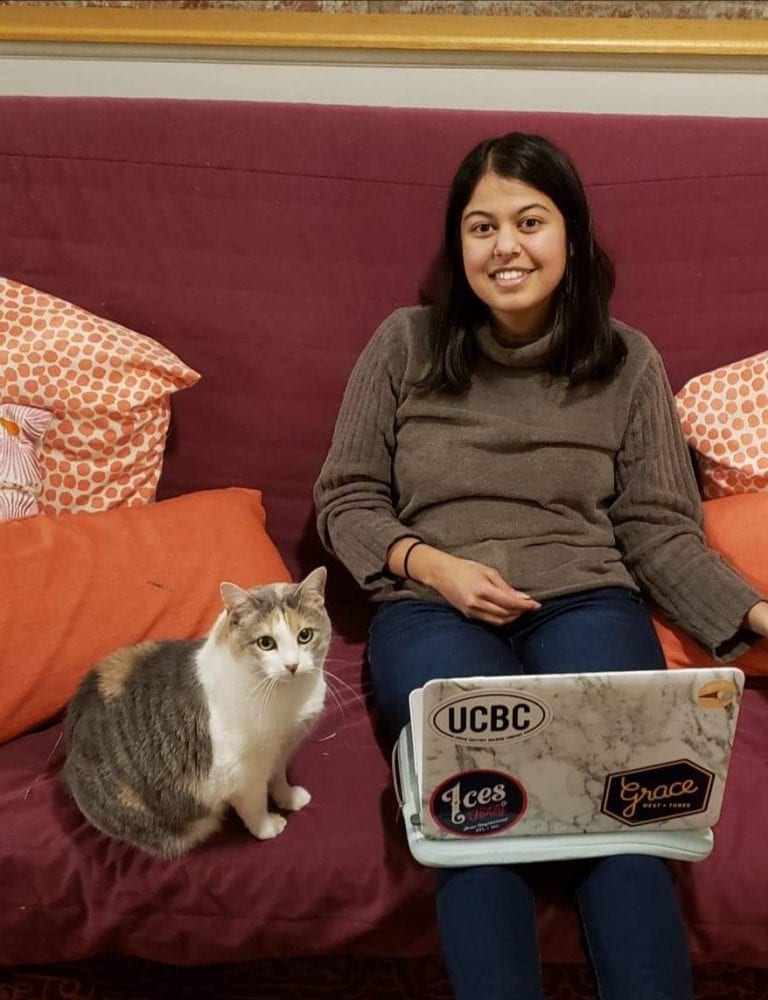Atheism/Agnosticism
Toby M., M4
It’s not challenging to be an atheist or agnostic in medical school: don’t be a theist or don’t be a gnostic. It’s so easy you will hardly ever think about it, and you will probably never be asked about it. It should come as no surprise that you will have plenty of good company among scientists and doctors. From Dr. Carl Sagan to Dr. Oliver Sacks, there have been many before you and there will be many after you. That being said, there are not many avenues to advocate for atheism or agnosticism. There is no club (although you could start one). The closest thing you’ll find to activism is this blurb. That’s just fine with us, though. If you’re looking for support for your skepticism, look no further than the contents of every lecture.
Bahá’í Faith
Gabby A.-G., M4
There is a great Bahá’í community at WUSM and in the greater St. Louis area that hosts devotionals, study circles, and different service activities throughout the city. It’s a really welcoming, supportive, and ethnically diverse group. St. Louis also isn’t too far from the Bahá’í temple in Wilmette, Illinois, so some people take a weekend trip to Chicago to visit and spend time there. It’s a really wonderful community!
Catholicism
Chris N., M1
My name is Chris, and I am so glad that you are considering WashU. Please know that I am praying for you and your journey into the medical profession. As you might guess, being a practicing Catholic and a medical professional has its challenges. This hopefully should not discourage you, but rather inspire a deeper love within you for advancing both your faith and your medical practice. We need Catholics at the forefront of medicine: It is within the Catholic spirit to pursue knowledge and better our communities. There are, however, important moral issues that you should be aware of and ready to talk about. WashU is not a Catholic institution, and you may find some of the practices here challenging. I would encourage you to lean into the discomfort and never be closed off to hearing other people’s thoughts. Don’t be afraid to be firm in your beliefs, but never miss an opportunity to love another human being and pray for God’s will to be done. I have found that the happiest I have been in medical school is when I have taken an extra moment here or there to offer my work to God and to pray for our community. We have a small group that likes to go to Mass and faculty dinners together, and we hope you will consider joining us!
Church of Jesus Christ of Latter-day Saints
Erik N., M1
WashU embraces diversity, religion included, which provides opportunities to see other perspectives and to share what I believe. This diversity also allows me to live my religion comfortably. The congregation here is absolutely fantastic and is full of many fellow professional students, several of whom are in the medical field. The temple is only 20 minutes from campus, which makes it easy to attend regularly. Remaining involved in church has helped my wife and I really become integrated into St. Louis. And don’t worry — of course we have church ball!
Hinduism
Gowri K., M1
St. Louis has a pretty vibrant Hindu community, and there are several places where one can get involved. The Hindu temple is in Town and Country, which is about a 20-minute drive from campus. It’s a really nice space — they have a full gopuram (the classic temple entrance tower) that makes quite the impression. They’re also building a new community center on their grounds, so I’m sure they’ll also have larger social events and poojas. I personally recommend going to the temple around lunchtime on Saturdays or Sundays: on weekends, the temple kitchen serves tiffin (South Indian brunch). In addition to the usual brunch offerings, they have idlis (savory fermented rice and lentil cakes) on Saturdays and dosas (savory crepes) on Sundays. The temple also has great snacks, like spicy mixture and laddus.
If you’d like to stay closer to campus, the ISKON organization has a small temple on Lindell. They have free dinner on Sundays which is quite tasty, but the services are definitely non-traditional (lots of sitting and tuneless chanting of “Hare Krishna”). The ISKON community is also very tightly knit, and they might try really hard to recruit you if you attend one service. I felt very welcomed, but I was also a little uncomfortable. Depending on your comfort level though, it could be a really nice experience. I know there are a few other places in St. Louis, but these are the two that I’m most familiar with.
Humanism
Weston M., M4
Medicine is all about humanism. That is to say, medicine is about empathy and respect for our patients and our colleagues. It is about striving for excellence and skill. It is about fighting for justice and defending the defenseless. It is about cultivating virtues like honesty, perseverance, and fortitude (even in the presence of terrifying sights and smells). It is about deeply valuing human life and endlessly battling against death and disease, its destroyers. So, every good physician is a humanist of some sort, whether a secular humanist like myself, a religious humanist like many of my amazing classmates, or even someone who shuns the term but is still driven by most of the same fundamental principles.
If you’re interested in organized Humanism with a capital H, St. Louis definitely has organizations. In fact, St. Louis is home to one of the oldest and largest Humanist congregations in the world, the Ethical Society of St. Louis, with its own impressive building and a full schedule of regular meetings and activities.
Islam
Fatima A. & Gazelle Z., M4s
Our Muslim community at Washington University includes the Muslim Student Association of the Danforth Campus and of Saint Louis University, which both undergraduate and graduate students may join. Although our immediate Muslim community within WUSM is relatively small, our neighbors are very active and inclusive. Students at the Danforth campus arrange rides to masjids (like the West Pine Masjid), host iftar and Eid parties, and organize Friday Jummah prayers. You can also attend Jummah at the hospital. Additionally, many Muslim students live in apartments close to WUSM (like Del Coronado) and there are plenty of opportunities to hang out outside of these formal events. In terms of socializing within your class: Although it’s true that many social events involve alcohol, your classmates understand that everyone has different ways of having a good time, and you’ll never feel any pressure. There’re also many non-drinking social alternatives (see the Perspectives Section: On Being Alcohol-Free).
Judaism
Sarah C., M1
Because I grew up in St. Louis, I had the opportunity from an early age to participate in St. Louis’ vibrant Jewish community. For anyone interested in religious opportunities, St. Louis has multiple reform, conservative, and orthodox congregations. Central Reform Congregation is within walking distance of the medical school. In addition, WashU undergrad has both Hillel and Chabad chapters, the WashU graduate schools have an organization called JGrad, and the medical school has a chapter of the Jewish Medical Student Association. St. Louis also has many Jewish organizations that students can volunteer with, such as the Jewish Food Pantry, National Council for Jewish Women, STL Jewish and Muslim Day of Service, Jewish Community Relations Council, Holocaust Museum and Learning Center, and more. All of these organizations afford medical students multiple options for involvement in the Jewish community at whatever level suits them, whether through religious services, Shabbat dinners, social events, or volunteering.
On Being Alcohol-Free
Ashwin L., M1
Avoiding alcohol can seem daunting in medical school, when so many events involve drinking at nightclubs, bars, and parties. After all, you want to connect with your class, build your social environment, and have a good time like anyone else. Whether you don’t drink for religious, cultural, health, and/or personal reasons, the truth is that you can do all these things and more. It’s totally possible to have fun at house parties, post-exam celebrations, and nights out — no one pressures you to drink, and you can still let loose and enjoy yourself in your own way.
Outside of parties, there are so many social activities to choose from — sports, going to the movies, baseball games, weekly board game nights (super popular in our year), bake-offs, museum trips, and more. We have such a supportive social environment that you can make friendships and memories in a multitude of ways. I’ve had loads of fun and a great quality of life socially without touching alcohol, and if you want, you can too!
On Being Asian-American
Tiffany W., M2
Often used in sweeping references, the term “Asian-American” does little justice to the enormous variety of life experiences and family backgrounds you may bring to the table. While Missouri may have a relatively lower population percentage of Asian-Americans, WashU has many students and faculty with whom you will find valuable cultural common ground. Rather than letting a fear of isolation discourage you, explore both sides of your hyphenated ethnic identity, perhaps through a student group like APAMSA. Then use your valuable platform to build bridges with those who might not fall inside the same checkbox as you! P.S. Ask around for food recommendations!
On Being Black
Jason M., M2
Coming from Atlanta, and then a liberal undergraduate institution, I was nervous about moving to St. Louis. However, my experience at WUSM has been incredible. St. Louis is a complicated city and the faculty and staff here do a great job of educating the class about how past events have shaped factors of inequality here, as well as empowering students to get involved with and make a difference in the local community. Within the medical school, the faculty and students also work to create a welcoming and engaging community for minority students. No place is perfect, but there are numerous channels in place to ensure that WUSM maintains a positive and supportive learning environment for everyone. My peers of all races here have continually impressed me with their willingness and ability to engage in difficult discussions and contemplate the impact that privilege, or lack thereof, has had on their lives. Being black in medicine has its challenges, but WUSM arms you with the resources to thrive here, and St. Louis provides an opportunity to live, work, and play in a large black community.
On Being Conservative
Mitchell L., M3
School, and medical school in particular, should be a time of growth, and growth does not come from being comfortable. WUSM is like many other universities in that the conservative voice tends to be in the minority. At times this can be challenging, but that challenge is a good thing. Being surrounded solely by people who agree with you tends to foster group polarization without necessarily grounding ideas any further. There is nothing inherently wrong with leaning right (or left) as long as you have a strong enough foundation to support your beliefs. Being a conservative at WUSM means that you will frequently meet people who come from a completely different point of view and so have arrived at quite different conclusions. If you are careful to be respectful of others, then I think you will find your experience here to be enjoyable and transformative.

On Being Hispanic
Jesús B., M1
Coming to St. Louis, I wasn’t sure what to expect in terms of the Hispanic community both in my own class and in the surrounding area. While it wouldn’t compare to communities in places like Chicago or California, I was happy growing up in the Hispanic community in Indianapolis and hoped that St. Louis/WashU could offer something similar. I was pleasantly surprised to experience the sense of community upon starting school. I quickly signed up for the medical Spanish selectives, which are a part of the relatively new four-year Spanish curriculum that aims to train bilingual physicians. It has been a great way to meet and converse in Spanish with other classmates. I also became involved with the Latino Medical Student Association (LMSA) chapter. The organization provides opportunities in service, policy, mentoring, advocacy, and social events. I have enjoyed volunteering at health screenings, where translators are often needed. Spanish speakers can also volunteer at Casa de Salud, a clinic focused on uninsured immigrant populations who face barriers to health care. I hope to become involved with the organization in the future.
In St. Louis itself, Cherokee Street (15 minutes from WUSM) and the surrounding neighborhood is well known as a Hispanic hub due to its abundance of Hispanic restaurants, bakeries, grocery stores, and clothing stores. In other areas, there are also other popular Hispanic cuisine spots including El Burro Loco, Nixta, and Mission Taco (a class favorite due to their late-night special of $2 tacos & tequila). Additionally, with the help of the salsa lessons offered through one of our student groups, you can practice your dance skills at places like Club Viva. There are also festivals like the Día de Los Muertos, the Greater St. Louis Hispanic Festival, and Cinco de Mayo, among others that occur throughout the year. Overall, St. Louis and WashU have plenty to offer in the Hispanic department!
On Being LGBTQIA+
Thomas V., M1
In my role as admissions liaison for LGBTQmed (the queer and allied student group here at WUSM), the question I get most often from applicants has been, “Is St. Louis the kind of city you can be ‘out’ in?”
This is a fair question: We are in the Midwest, and Missouri doesn’t have the best track record when it comes to LGBTQ rights. But St. Louis has a great history of LGBTQ inclusion, has a perfect Municipal Equality Index score from the Human Rights Campaign, and is consistently highly ranked by The Advocate’s list of the Queerest Cities in America (#4 in 2016!). And the Central West End and The Grove boast some great bars, drag clubs, and LGBTQ-owned businesses for you to try during your time here.
But more importantly than these tangibles, I have found that WashU as an institution celebrates diversity in all its forms, not as a way to check a box but as a way to make everyone’s education that much more powerful. LGBTQmed has a great mentorship program with OUTMed, the organization for queer physicians at WashU, and I love that I get to study at a place that not only makes sure I am safe being who I am, but also encourages me to lean into my whole self and to help my classmates learn from my experiences as I learn from theirs.

On Being Progressive
Marina N., M1
I was initially a little terrified of moving to Missouri. After my interview here, I still remember walking in the CWE and noticing a sign in the Whole Foods window stating you couldn’t bring concealed weapons into the store. What?! People here are normally carrying their guns around? After growing up in California (and let me tell you, my hometown of Santa Cruz is a special type of liberalism and hippie-ism, even for California standards), and then studying and working in the Northeast, I could not imagine moving to a red state.
I’m not going to lie, I still haven’t gotten used to Missouri conservatism (and hopefully I never will), and there are political, social, and economic issues here that are incredibly frustrating. It also doesn’t help that our one Democratic senator (bye, Claire) lost her seat to a Republican in the most recent midterm elections, and that when I looked up how Missourians voted, the whole state was red — except for a few pockets, including a very blue St. Louis!
So that brings me to the best part — St. Louis is a very liberal city, and except for the whole guns thing, I’ve felt quite at home. I’ve also been surprised by how many liberal and progressive areas do exist. If you take a walk in Tower Grove, for example, you’ll find many homes displaying banners stating “Black Lives Matter” or “No Human Being is Illegal.” There are multiple progressive bubbles in the city with passionate folks who want to make a change in Missouri. Just to give you an idea, check out Left Bank Books in CWE (“Literacy and justice for all!”).
Regarding the medical school, it’s probably not surprising that most of my classmates tend to lean liberal, and from what I’ve gathered from my interactions with faculty and physicians at WashU, they also tend to lean more liberal. That being said, WUSM may not be the school where you’ll find many medical students actively engaged in activism, although I truly believe this could change! And quite frankly, sometimes I feel like I’m talking into a void when I go on some political or social justice rant.
However, overall, I have sincerely appreciated leaving my liberal bubbles and moving to the Midwest. It’s been an eye-opening experience, and one that I believe is critical during this time. I recommend truly listening to other people, trying to understand their perspectives, and staying open-minded. So, come to Missouri, and please register to vote!

On Being South Asian
Sukruth S., M1
It was around April 2014, and I had made the decision to commit to Washington University for undergrad. I grew up surrounded by a support network of South Asians in a community where roughly 15% of the population was Asian. So, knowing that the Asian-American population of St. Louis was lower than what I was accustomed to while growing up, I was a bit apprehensive of moving, although my parents, who attended graduate school in Missouri, told me there had already been a sizable population of South Asians in the greater St. Louis area by the early ’90s.
I soon found out, however, that WashU has many students and faculty with whom I share a cultural background. Through WUSM’s Asian Pacific American Medical Student Association (APAMSA) chapter, fellow Desi (and non-Desi) Americans and I celebrated Diwali with fun dance and lots of good food.
If you’re craving some creamy mutter paneer, South Asian restaurants abound in CWE and the greater St. Louis area. A classic is Rasoi in the CWE; I would also recommend Taj Mahal (on the Delmar Loop) and India Palace (in Maryland Heights – go for the buffet and snag some groceries at the neighboring Indian store while you’re there!). Seema is a chain of South Asian grocery stores throughout the greater St. Louis area (15 minutes away by car), but for something closer, check out United Provisions (on the Delmar Loop, 7 minutes by car).
You can visit the Hindu Temple of St. Louis, a large, peaceful place of worship (20 minutes away by car) that regularly hosts events; the Sikh Gurdwara is also 30 minutes away. The South Asian community in St. Louis is pretty involved — I’ve been invited to attend Kannada community events by people I’d just met. And at night, Club Viva in the CWE hosts Bollywood dance nights, so grab a group of friends and dance the night away to old and new Bollywood hits.
It didn’t take much searching to see that South Asians are very much present in the greater St. Louis area. (Check out our local Costco to get an idea!!) Now, almost five years later, I can reassure my younger, apprehensive self that the Asian-American community of St. Louis stands strong.

On Having a Cat
Urvi S., M1
Although adopting a pet during, or bringing your pet to, medical school can seem intimidating, always remember what I heard from an M2 (at another institution) on the interview trail: “Can you have a cat in medical school? I have three kids and I’m in medical school. Of course you can have a cat!” St. Louis is a pretty pet-friendly city, and as someone who grew up with no siblings and no pets, my dearest wish as a recent college grad was to have a fluffy buddy to call my own. My cat helps me balance self-care with medical school: Taking care of another living thing reminds me that I can and should have priorities outside of Anki, and never more than when my cat sits on my keyboard and skips 50 Anatomy flashcards the night before an exam.
On Having a Dog
Meg G., M1
Having a dog in medical school (and in life) is the single greatest choice I have made. I’m exaggerating slightly, but seriously — I love having a dog. Besides being adorable and endlessly loving, my dog is a great study buddy and keeps me happy and sane during exam periods. With a dog, I am forced to get outside at least a couple times a day, which is a welcome break from studying inside.
All of that being said, having a dog in medical school is A LOT OF WORK. There are times you will come home from school and discover your dog has eaten everything in the pantry. Not only will you have to clean the mess, but you will also have to deal with the digestive aftermath for the next three days (true story). Beyond the day-to-day work, dogs are extremely expensive. Doggy health care doesn’t work the same way as human health care, so vet bills tend to be entirely out of pocket. Finally, having a dog in medical school requires advanced schedule planning. I map out the days I will not be able to walk him and schedule a walker for those days ($). I also have to find a pet sitter for him weeks in advance when I leave on vacations (more $$).
Overall, loving and caring for a dog has been an incredibly rewarding experience. It is entirely possible to have a dog in medical school, but everyone should weigh the pros and cons first before deciding to adopt!